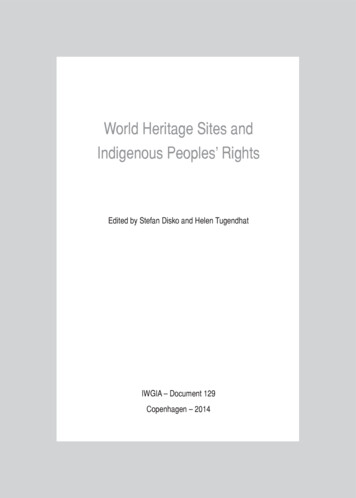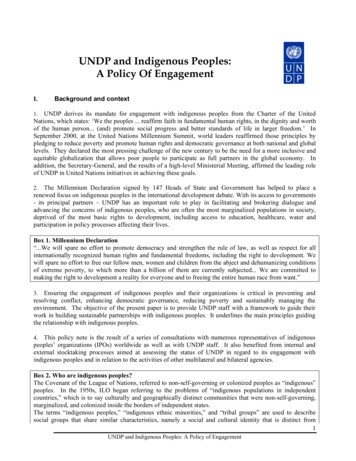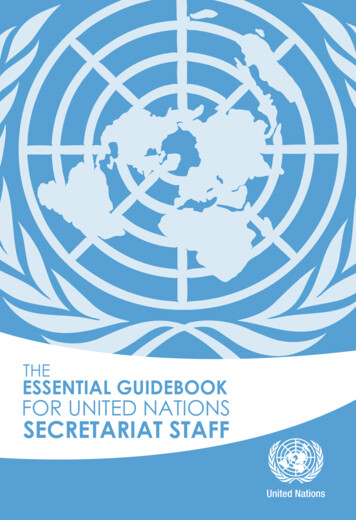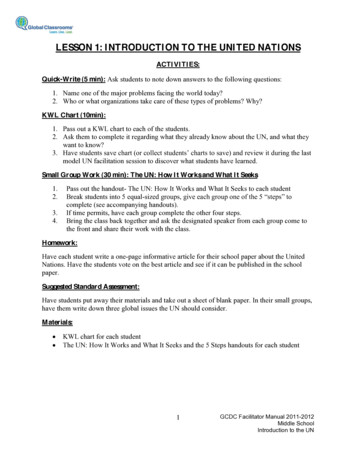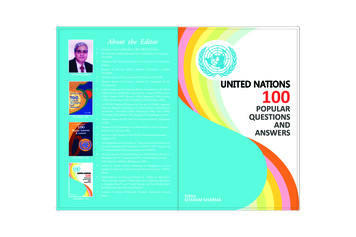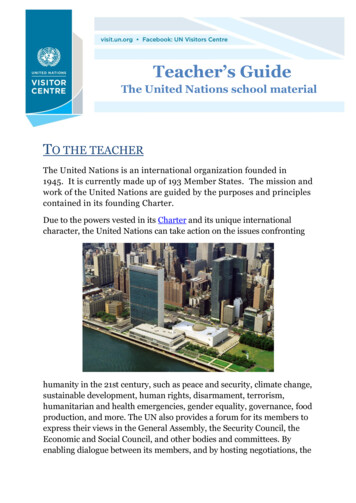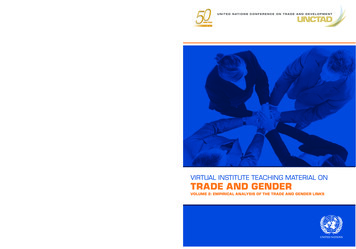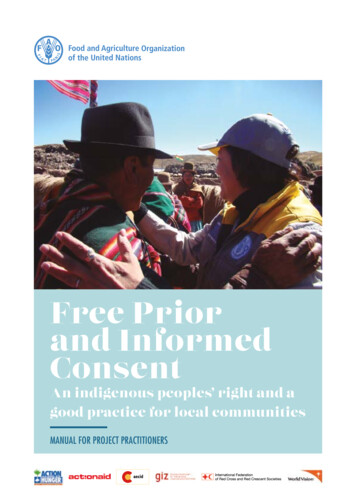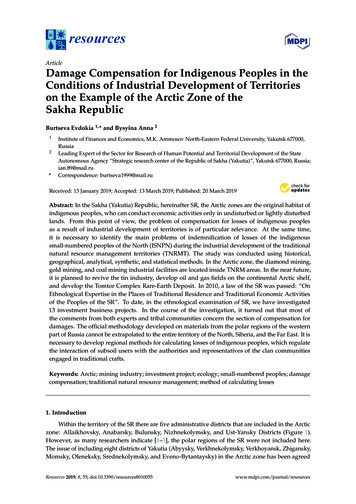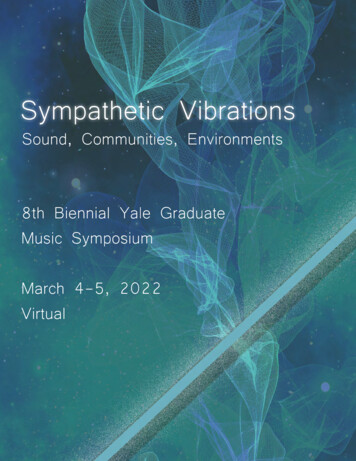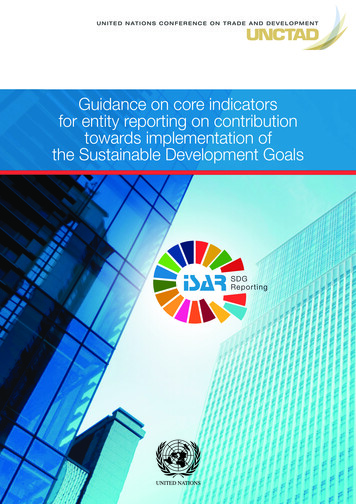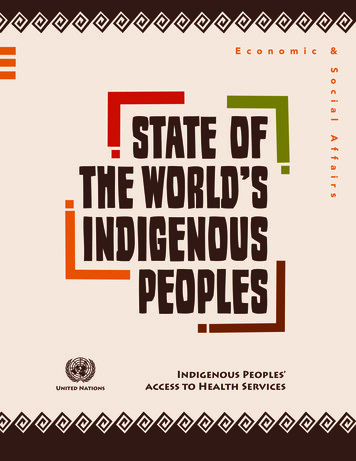
Transcription
United NationsIndigenous Peoples’access to Health Services
state of the world’sindigenous peoplesIndigenous Peoples’ accessto Health ServicesUnited Nations
State of the World’s Indigenous PeoplesDESAThe Department of Economic and Social Affairs of the United Nations is a vital interface betweenglobal policies in the economic, social and environmental spheres and national action. The Department works in three main interlinked areas: (i) it compiles, generates and analyses a widerange of economic, social and environmental data and information on which Member States ofthe United Nations draw to review common problems and to take stock of policy options; (ii) itfacilitates the negotiations of Member States in many intergovernmental bodies on joint courseof action to address ongoing or emerging global challenges; and (iii) it advises interested Governments on ways and means of translating policy frameworks developed in United Nations conferences and summits into programmes at the country level and, through technical assistance, helpsbuild national capacities.NoteThe views expressed in this publication do not necessarily reflect those of the United Nations.The designations employed and the presentation of the material in this publication do not implythe expression of any opinion whatsoever on the part of the Secretariat of the United Nationsconcerning the legal status of any country or territory or of its authorities, or concerning the delimitations of its frontiers.The designations of country groups in the text and the tables are intended solely for statistical oranalytical convenience and do not necessarily express a judgement about the stage reached by aparticular country or area in the development process.Mention of the names of firms and commercial products does not imply the endorsement of theUnited Nations.Symbols of United Nations documents are composed of capital letters combined with figures.ii ξ
Indigenous Peoples’ access to Health ServicesAcknowledgementsThe State of the World’s Indigenous Peoples has been a collaborative effort of experts and organizations. The introduction was written by the secretariat of the Permanent Forum on IndigenousIssues within the Division for Social Policy and Development of the Department of Economic andSocial Affairs. The thematic chapters were written by Ms. Oksana Buranbaeva, Dr. Myriam ConejoMaldonado, Dr. Ketil Lenert Hansen, Dr. Mukta S. Lama, Dr. Priscilla S. Migiro and Dr. Collin Tukuitonga. The Secretariat of the Permanent Forum on Indigenous Issues oversaw the preparationof the publication. Special acknowledgements go to the editor, Jeffrey Reading, translator RaulMolina, and also the UN Graphic Design Unit, Department of Public Information.Ms. Shamshad Akhtar, Assistant-Secretary-General for Economic Development and Senior Advisor on Economic Development and Finance, of the Department of Economic and Social Affairsprovided invaluable comments.ξiii
Indigenous Peoples’ access to Health ServicesForeword to the State of theWorld’s Indigenous PeoplesBy Mr. Wu Hongbo, Under-Secretary-General for Economic and Social AffairsOver the past two decades, international efforts have been made to improve the rights of indigenous peoples, to bring awareness to their issues, including their engagement in developing policyand programmes in order to improve their livelihoods. In the First Decade of the World’s Indigenous People (1995-2004) the United Nations created the United Nations Permanent Forum onIndigenous Issues as well as the Special Rapporteur on the rights of indigenous peoples. Duringthe Second Decade of the World’s Indigenous People (2005-2015), there have been further initiatives such as the creation of Expert Mechanism on the Rights of Indigenous Peoples. The adoptionof the United Nations Declaration on the Rights of Indigenous Peoples in September 2007 was amajor step for the United Nations as the Declaration had been debated for over 20 years.The United Nations Permanent Forum on Indigenous Issues is an advisory body to the Economicand Social Council with a mandate to discuss indigenous issues related to economic and socialdevelopment, culture, the environment, education, health and human rights. At its twelfth session, the Permanent Forum on Indigenous Issues reviewed health as one of its mandated areasand stated the right to health materializes through the well-being of an individual as well as thesocial, emotional, spiritual and cultural well-being of the whole community.1The United Nations Declaration on the Rights of Indigenous Peoples states that indigenous peoples have the right to be actively involved in developing and determining their health programmes;the right to their traditional medicines, maintain their health practices, and the equal right to theenjoyment of the highest attainable standard of physical and mental health. Unfortunately, indigenous peoples suffer higher rates of ill health and have dramatically shorter life expectancy thanother groups living in the same countries. This inequity results in indigenous peoples sufferingunacceptable health problems and they are more likely to experience disabilities and dying at ayounger age than their non-indigenous counterparts.Indigenous peoples’ health status is severely affected by their living conditions, income levels,employment rates, access to safe water, sanitation, health services and food availability. Indigenous peoples are facing destruction to their lands, territories and resources, which are essentialto their very survival. Other threats include climate change and environmental contamination(heavy metals, industrial gases and effluent wastes).Indigenous peoples also experience major structural barriers in accessing health care. These include geographical isolation and poverty which results in not having the means to pay the highcost for transport or treatment. This is further compounded by discrimination, racism and a lack ofcultural understanding and sensitivity. Many health systems do not reflect the social and culturalpractices and beliefs of indigenous peoples.1E/2013/43 p. 2.ξv
State of the World’s Indigenous PeoplesAt the same time, it is often difficult to obtain a global assessment of indigenous peoples’ healthstatus because of the lack of data. There has to be more work undertaken towards building onexisting data collection systems to include data on indigenous peoples and their communities.This publication sets out to examine the major challenges for indigenous peoples to obtain adequate access to and utilization of quality health care services. It provides an important background to many of the health issues that indigenous peoples are currently facing. Improvingindigenous peoples’ health remains a critical challenge for indigenous peoples, States and theUnited Nations.vi ξ
Indigenous Peoples’ access to Health ServicesContentsForeword to the State of the World’s Indigenous Peoplesby Mr. Wu Hongbo, Under-Secretary-General for Economic and Social Affairs. . . . . . . . . . . . . ivIntroduction . . . . . . . . . . . . . . . . . . . . . . . . . . . . . . . . . . . . . . . . . . . . . . . . . . . . . . . . . . . . . . . . 002The concept of indigenous peoples . . . . . . . . . . . . . . . . . . . . . . . . . . . . . . . . . . . . . . . . . . 003Article 33. . . . . . . . . . . . . . . . . . . . . . . . . . . . . . . . . . . . . . . . . . . . . . . . . . . . . . . . . . . . . . . 005About this publication . . . . . . . . . . . . . . . . . . . . . . . . . . . . . . . . . . . . . . . . . . . . . . . . . . . . 006Overview of major international responses to indigenous peoples. . . . . . . . . . . . . . . . . . 008Chapter OneAccess to Health Services by Indigenous Peoples in the African Regionby Dr. Priscilla Santau Migiro . . . . . . . . . . . . . . . . . . . . . . . . . . . . . . . . . . . . . . . . . . . . . . . . . . 010Introduction. . . . . . . . . . . . . . . . . . . . . . . . . . . . . . . . . . . . . . . . . . . . . . . . . . . . . . . . . . . . . . 011Conclusion. . . . . . . . . . . . . . . . . . . . . . . . . . . . . . . . . . . . . . . . . . . . . . . . . . . . . . . . . . . . . . . 028References: . . . . . . . . . . . . . . . . . . . . . . . . . . . . . . . . . . . . . . . . . . . . . . . . . . . . . . . . . . . . . . 028Chapter TwoAccess to Health Services by Indigenous Peoples in Asiaby Dr. Mukta Lama. . . . . . . . . . . . . . . . . . . . . . . . . . . . . . . . . . . . . . . . . . . . . . . . . . . . . . . . . . . 032Introduction. . . . . . . . . . . . . . . . . . . . . . . . . . . . . . . . . . . . . . . . . . . . . . . . . . . . . . . . . . . . . . 033Conclusion. . . . . . . . . . . . . . . . . . . . . . . . . . . . . . . . . . . . . . . . . . . . . . . . . . . . . . . . . . . . . . . 054References. . . . . . . . . . . . . . . . . . . . . . . . . . . . . . . . . . . . . . . . . . . . . . . . . . . . . . . . . . . . . . . 055Chapter ThreeAccess to Health Services by Indigenous Peoples in the Arctic Regionby Ketil Lenert Hansen, PhD . . . . . . . . . . . . . . . . . . . . . . . . . . . . . . . . . . . . . . . . . . . . . . . . . . . 058Introduction. . . . . . . . . . . . . . . . . . . . . . . . . . . . . . . . . . . . . . . . . . . . . . . . . . . . . . . . . . . . . . 059Conclusion. . . . . . . . . . . . . . . . . . . . . . . . . . . . . . . . . . . . . . . . . . . . . . . . . . . . . . . . . . . . . . . 077References . . . . . . . . . . . . . . . . . . . . . . . . . . . . . . . . . . . . . . . . . . . . . . . . . . . . . . . . . . . . . . 077Chapter FourAccess to Health Services by Indigenous Peoples in Central, South America andthe Caribbean Regionby Dr. Myriam de Rocio Conejo Maldonado. . . . . . . . . . . . . . . . . . . . . . . . . . . . . . . . . . . . . . . . 081Introduction. . . . . . . . . . . . . . . . . . . . . . . . . . . . . . . . . . . . . . . . . . . . . . . . . . . . . . . . . . . . . . 082Conclusion. . . . . . . . . . . . . . . . . . . . . . . . . . . . . . . . . . . . . . . . . . . . . . . . . . . . . . . . . . . . . . 098Bibliography . . . . . . . . . . . . . . . . . . . . . . . . . . . . . . . . . . . . . . . . . . . . . . . . . . . . . . . . . . . . 099Internet sites. . . . . . . . . . . . . . . . . . . . . . . . . . . . . . . . . . . . . . . . . . . . . . . . . . . . . . . . . . . . . 101Special documents . . . . . . . . . . . . . . . . . . . . . . . . . . . . . . . . . . . . . . . . . . . . . . . . . . . . . . . . 101ξ vii
State of the World’s Indigenous PeoplesChapter FiveAccess to Health Services by Indigenous Peoples in North America . . . . . . . . . . . . . . . . . . . . 103Introduction. . . . . . . . . . . . . . . . . . . . . . . . . . . . . . . . . . . . . . . . . . . . . . . . . . . . . . . . . . . . . . 104Conclusion. . . . . . . . . . . . . . . . . . . . . . . . . . . . . . . . . . . . . . . . . . . . . . . . . . . . . . . . . . . . . . . 126Bibliography . . . . . . . . . . . . . . . . . . . . . . . . . . . . . . . . . . . . . . . . . . . . . . . . . . . . . . . . . . . . . 126Chapter SixAccess to Health Services by Indigenous Peoples in the Pacific Regionby Dr. Collin Tukuitonga . . . . . . . . . . . . . . . . . . . . . . . . . . . . . . . . . . . . . . . . . . . . . . . . . . . . . . 130Introduction . . . . . . . . . . . . . . . . . . . . . . . . . . . . . . . . . . . . . . . . . . . . . . . . . . . . . . . . . . . . . . 131Discussion . . . . . . . . . . . . . . . . . . . . . . . . . . . . . . . . . . . . . . . . . . . . . . . . . . . . . . . . . . . . . . . 151Bibliography . . . . . . . . . . . . . . . . . . . . . . . . . . . . . . . . . . . . . . . . . . . . . . . . . . . . . . . . . . . . . 155Appendix. . . . . . . . . . . . . . . . . . . . . . . . . . . . . . . . . . . . . . . . . . . . . . . . . . . . . . . . . . . . . . . . 157Chapter SevenAccess to Health Services by Indigenous Peoples in the Russian FederationBy Oksana Buranbaeva . . . . . . . . . . . . . . . . . . . . . . . . . . . . . . . . . . . . . . . . . . . . . . . . . . . . . . . 158Introduction . . . . . . . . . . . . . . . . . . . . . . . . . . . . . . . . . . . . . . . . . . . . . . . . . . . . . . . . . . . . . 159Conclusion. . . . . . . . . . . . . . . . . . . . . . . . . . . . . . . . . . . . . . . . . . . . . . . . . . . . . . . . . . . . . . . 180List of references . . . . . . . . . . . . . . . . . . . . . . . . . . . . . . . . . . . . . . . . . . . . . . . . . . . . . . . . . 181viii ξ
Indigenous Peoples’ access to Health ServicesUN PhotoIntroductionIntroduction ξ001
IntroductionAt its first session, the United Nations Permanent Forum on Indigenous Issues requested the United Nations System produce such a report on the state of the world’s indigenous peoples.2 It wasalso suggested the report be a key advocacy tool for raising awareness on indigenous peoples’issues in general and in particular to raise the profile of the Permanent Forum. In addition, thereport should be of value for deliberations within the Economic and Social Council, the GeneralAssembly and other bodies of the UN system.The first publication of The State of the World’s Indigenous Peoples was published in 2009 andits major focus was on: Poverty and Well-being; Culture; Environment; Contemporary Education;Health; Human Rights and Emerging Issues. The report was well received, and, according to pressreports, the publication revealed alarming statistics on indigenous peoples’ poverty, health, education, employment, human rights, the environment and more. This was the first United Nationspublication and provided much needed information on the status of indigenous peoples throughout the world.The State of the World’s Indigenous Peoples will remain a recurrent “flagship” publication produced by the United Nations. It is intended that publications such as this will deal with a broadspectrum of indigenous peoples’ issues. It is hoped that such a publication, given its functionof supporting the United Nations Permanent Forum, will also promote awareness of indigenouspeoples’ issues within the United Nations system, with States, academia and the broader public.The current situation of indigenous peoples remains a concern within the United Nations. It hasbeen estimated that the world’s 370 million indigenous peoples reside in approximately 90 countries of the world.3 They are among the world’s most marginalized peoples, and are often isolatedpolitically and socially within the countries where they reside by the geographical location of theircommunities, their separate histories, cultures, languages and traditions. They are often amongthe poorest peoples and the poverty gap between indigenous and non-indigenous groups is increasing in many countries around the world. This influences indigenous peoples’ quality of lifeand their right to health.Indigenous peoples’ access to adequate health care remains one of the most challenging andcomplex areas. There is an urgent need to focus on health issues as well as alternative healthcare frameworks. As previously stated, health is one of the six mandated areas of the UnitedNations Permanent Forum on Indigenous Issues and is one of the focuses of the World HealthOrganization, which recognizes the right to health as a fundamental human right in its constitution. The United Nations Declaration on the Rights of Indigenous Peoples includes articles (21,23, 24 and 29) that refer specifically to the right to health, including indigenous peoples’ right toimproving their economic and social conditions in the area of health, with particular attentionto the needs of indigenous elders, women, youth, children and persons with disabilities. Further,indigenous peoples have the right to determine their health programmes and to administer theseprogrammes through their own institutions, as well as maintain their traditional health practices.2Permanent Forum on Indigenous Issues, Report on the First session (12-24 May 2002) E/2002/43.3Harry Patrinos and Gillette Hall, Indigenous Peoples, Poverty and Development, 2010, p. 8.
Indigenous Peoples’ access to Health ServicesAlso, that States take effective measures to ensure that programmes for monitoring, maintainingand restoring the health of indigenous peoples, as developed and implemented by the peoplesaffected by such materials, are duly implemented.Indigenous peoples face a myriad of obstacles when accessing public health systems. These include the lack of health facilities in indigenous communities and cultural differences with thehealth care providers such as differences in languages, illiteracy and lack of understanding of indigenous culture and traditional health care systems. There is also an absence of adequate healthinsurance or lack of economic capacity to pay for services. As a result, indigenous peoples oftencannot afford health services even if it is available. Marginalization also means that indigenouspeoples are reluctant or have difficulties in participating in non-indigenous processes or systemsat the community, municipal, state and national levels.There are also major concerns regarding the lack of data on indigenous peoples’ health and socialconditions. Not only is there a lack of disaggregated data based on ethnicity but also data relatedto the location of indigenous peoples’ residence such as urban, rural or isolated areas. As a result,there is a lack of information, analysis and evaluation of programmes and services relating to indigenous peoples’ health situation.One of the important areas for health care for indigenous peoples lies in intercultural frameworksand models of care. Health care services need to be pluricultural in order to develop effectivemodels of care and best practices so that such programmes and services are culturally and linguistically appropriate for indigenous peoples. Also, indigenous peoples must be able to participate in the design and implementation of comprehensive health plans, policies and programmes.It has been estimated that over 80 per cent of the world’s indigenous peoples live in Asia, LatinAmerica and Africa,. However, there is still little information known about their health status andtheir levels of access to health services. Even in wealthy nations, most studies indicate an alarming health disadvantage for indigenous peoples. Historically, indigenous peoples have suffered theimpact of colonization and assimilation policies as well as the imposition of foreign developmentmodels. Indigenous peoples continue to suffer discrimination in their own countries which has amajor impact on their lives, in particular, their health. Indigenous peoples are not only a marginalized group with health problems, they are also highly aware of their situation, quite political andwilling to work to towards improving their health and social status. Therefore, indigenous peopleshave the right to determine their own policies, strategies and interventions in order to obtain thehighest attainable standards of health and health services, as set out in the United Nations Declaration on the Rights of Indigenous Peoples.The concept of indigenous peoplesThere has been considerable debate devoted to the question of the definition or understandingof “indigenous peoples” however, no such definition has ever been adopted by any United Nationsbody, and the prevailing view today is that no formal universal definition is necessary for the recognition and protection of their rights.One of the most cited descriptions of the concept of “indigenous” was outlined in the José R.Martínez Cobo’s Study on the Problem of Discrimination against Indigenous Populations. AfterIntroduction ξ003
State of the World’s Indigenous Peoplesconsideration of the issues involved, Martínez Cobo offered a working definition of “indigenouscommunities, peoples and nations”. In doing so, he expressed a number of basic ideas formingthe intellectual framework for this effort, including the right of indigenous peoples themselves todefine what and who are indigenous peoples. The working definition is as follows:Indigenous communities, peoples and nations are those which, having a historical continuity with pre-invasion and pre-colonial societies that developed on their territories, considerthemselves distinct from other sectors of the societies now prevailing on those territories,or parts of them. They form at present non-dominant sectors of society and are determinedto preserve, develop and transmit to future generations their ancestral territories, and theirethnic identity, as the basis of their continued existence as peoples, in accordance with theirown cultural patterns, social institutions and legal system.This historical continuity may consist of the continuation, for an extended period reaching intothe present of one or more of the following factors:a. Occupation of ancestral lands, or at least of part of them.b. Common ancestry with the original occupants of these lands.c. C ulture in general, or in specific manifestations (such as religion, living under a tribal system, membership of an indigenous community, dress, means of livelihood, lifestyle, etc.).d. L anguage (whether used as the only language, as mother tongue, as the habitual meansof communication at home or in the family, or as the main, preferred, habitual, general ornormal language).e. Residence in certain parts of the country, or in certain regions of the world.f. Other relevant factors.On an individual basis, an indigenous person is one who belongs to these indigenous populations through self-identification as indigenous (group consciousness) and is recognized andaccepted by these populations as one of its members (acceptance by the group). This preservesfor these communities the sovereign right and power to decide who belongs to them withoutexternal interference.4During the many years of debate at the meetings of the Working Group on Indigenous Populations, observers from indigenous organizations developed a common position that rejected theidea of a formal definition of indigenous peoples at the international level to be adopted by States.Similarly, government delegations expressed the view that it was neither desirable nor necessaryto elaborate a universal definition of indigenous peoples. Finally, at its fifteenth session, in 1997,the Working Group concluded that a definition of indigenous peoples at the global level was notpossible at that time, and this did not prove necessary for the adoption of the Declaration on theRights of Indigenous Peoples.5 Instead of offering a definition, Article 33 of the United Nations4Martínez Cobo (1986-1987), paras. 379-382.5Working Group on Indigenous Populations (2006a) and (2006b), paras. 153-154.004 ξIntroduction
Indigenous Peoples’ access to Health ServicesDeclaration on the Rights of Indigenous Peoples underlines the importance of self-identification,that indigenous peoples themselves define their own identity as indigenous.Article 331. I ndigenous peoples have the right to determine their own identity or membership in accordance with their customs and traditions. This does not impair the right of indigenous individuals to obtain citizenship of the States in which they live.2. I ndigenous peoples have the right to determine the structures and to select the membership of their institutions in accordance with their own procedures.ILO Convention No. 169 also enshrines the importance of self-identification. Article 1 indicatesthat self-identification as indigenous or tribal shall be regarded as a fundamental criterion fordetermining the groups to which the provisions of this Convention apply. Furthermore, this sameArticle 1 contains a statement of coverage rather than a definition, indicating that the Conventionapplies to:a. t ribal peoples in independent countries whose social, cultural and economic conditions distinguish them from other sections of the national community and whose status is regulated wholly or partially by their own customs or traditions or by special laws or regulations;b. p eoples in independent countries who are regarded as indigenous on account of their descent from the populations which inhabited the country, or a geographical region to whichthe country belongs, at the time of conquest or colonization or the establishment of present state boundaries and who irrespective of their legal status, retain some or all of theirown social, economic, cultural and political institutions.The concept of indigenous peoples emerged from the colonial experience, whereby the aboriginalpeoples of a given land were marginalized after being invaded by colonial powers, whose peoplesare now dominant over the earlier occupants. These earlier definitions of indigenousness makesense when looking at the Americas, Russia, the Arctic and many parts of the Pacific. However,this definition makes less sense in most parts of Asia and Africa, where the colonial powers didnot displace whole populations of peoples and replace them with settlers of European descent.Domination and displacement of peoples have, of course, not been exclusively practised by whitesettlers and colonialists; in many parts of Africa and Asia, dominant groups have suppressed marginalized groups and it is in response to this experience that the indigenous movement in theseregions has reacted.It is sometimes argued that all Africans are indigenous to Africa and that by separating Africansinto indigenous and non-indigenous groups, separate classes of citizens are being created withdifferent rights. The same argument is made in many parts of Asia or, alternatively, that there canbe no indigenous peoples within a given country since there has been no large-scale Westernsettler colonialism and therefore there can be no distinction between the original inhabitants andnewcomers. It is certainly true that Africans are indigenous to Africa and Asians are indigenous toAsia, in the context of European colonization. Nevertheless, indigenous identity is not exclusivelydetermined by European colonization.Introduction ξ005
State of the World’s Indigenous PeoplesThe Report of the Working Group of Experts on Indigenous Populations/Communities of the African Commission on Human and Peoples’ Rights therefore emphasizes that the concept of indigenous must be understood in a wider context than only the colonial experience:The focus should be on more recent approaches focusing on self-definition as indigenousand distinctly different from other groups within a state; on a special attachment to anduse of their traditional land whereby ancestral land and territory has a fundamental importance for their collective physical and cultural survival as peoples; on an experience of subjugation, marginalization, dispossession, exclusion or discrimination because these peopleshave different cultures, ways of life or modes of production than the national hegemonicand dominant model.6In the 60-year historical development of international law within the United Nations system, itis not uncommon that various terms have not been formally defined, the most vivid examplesbeing the notions of “peoples” and “minorities”. Yet the United Nations has recognized the rightof peoples to self-determination and has adopted the Declaration on the Rights of Persons Belonging to National or Ethnic, Religious and Linguistic Minorities. The lack of formal definition of“peoples” or “minorities” has not been crucial to the Organization’s successes or failures in thosedomains nor to the promotion, protection or monitoring of the rights accorded to these groups.Nor have other terms, such as “the family” or “terrorism” been defined, and yet the United Nationsand Member States devote considerable action and efforts to these areas.In conclusion, in the case of the concept of “indigenous peoples”, the prevailing view today is thatno formal universal definition of the term is necessary, given that a single definition will inevitablybe either over- or underincl
The United Nations Declaration on the Rights of Indigenous Peoples includes articles (21, 23, 24 and 29) that refer specifically to the right to health, including indigenous peoples' right to
